By Stephen T. Sinatra, M.D., F.A.C.C., F.A.C.N., C.N.S., C.B.T.
Just a few decades ago, the baking aisle of your local grocery store looked a whole lot different than it does today. Back then, your choices were simple…either bleached or unbleached all-purpose white flour. If you were lucky, you’d maybe even find whole-wheat flour for a little extra nutrition.
Today, the choices are endless and overwhelming. You’ll still find your basic all-purpose flour, along with countless other options: flours made from various gluten-free grains, nuts, legumes, or even seeds.
As a doctor, I’m happy about all these new options -even if it does mean a little more work navigating your choices. For one, people with celiac disease or gluten allergies/intolerances now have plenty of possibilities when it comes to baking safely. The same holds true for those who follow ketogenic or Paleo diets, which generally avoid wheat and other grains.
More importantly though, it comes down to health and nutrition. Today’s wheat is nothing like the wheat our ancestors grew and harvested. I honestly consider wheat—at least today’s version of it—a bit suspect. I’ve been steering clear of it, opting for other types of flours when I bake.
Here’s why…
Before industrialization in the early 1900s, all three components of wheat were used to make flour: the germ, bran, and endosperm. But all-purpose white flour gets rid of the germ and bran, and therefore all the nutrients.
White flour is basically ground up endosperm. It’s not typically white, so it gets bleached during processing. Then, because all the nutrients are stripped away, they are usually added back in at the end (it’s labeled as “enriched”).
To make matters worse, the Green Revolution in the 1950s led to big changes in the business of wheat. Genetic and chemical engineering entered the picture, and with it came routine use of synthetic fertilizers and pesticides. Yields increased dramatically. Farmers rejoiced and even consumers were pleased with the ability to buy more flour for less money. Experiments began with GMO wheat, and while wheat that has been genetically modified to resist drought, blight, and various pests is not commercially grown or sold on the market, it could be in the near future.
Now, of course, these “accomplishments” are seen as disasters for both our health and the environment. Most wheat is now grown in chemical-laden and nutrient-depleted soil, then stripped of any potential nutrients during processing. Is it any wonder wheat allergies and intolerances are on the rise?
Fortunately, these days there are dozens substitutes for white flour. Even better, most of them are far more nutritious and pretty easy to substitute if you understand each flour’s unique properties.
I am going to discuss a few of my favorites, but first, here are the basics on wheat flour.
All-Purpose White Flour
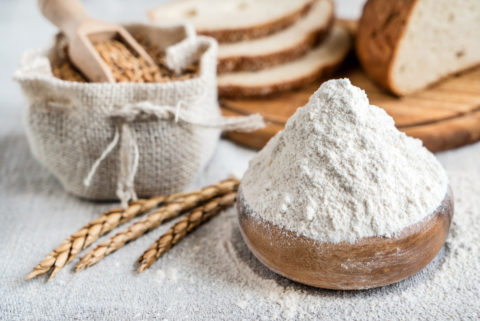 Nutritionally speaking, one cup of all-purpose white flour has:
Nutritionally speaking, one cup of all-purpose white flour has:
- Calories: 455
- Carbohydrates: 95g
- Fiber: 3.4g
- Protein: 12.9g
- Fat: 1g
Despite its lack of real health benefits, there’s a reason all-purpose flour is a kitchen staple. It’s extremely versatile, cheap, and able to be used in both cooking and baking. It’s completely tasteless, so it takes on whatever seasonings you add to it.
Of note, wheat flour contains gluten, which is the protein that binds dough and gives it that stretchy, elastic consistency when kneaded. Because of this, when baking with wheat-free/gluten-free flours, you need to use an alternative binding agent like xanthan gum, guar gum, psyllium husk, or additional eggs (which contain the binding agent lecithin) to achieve a final product that is similar in texture to wheat flour.
Now on to the alternatives…
Almond Flour
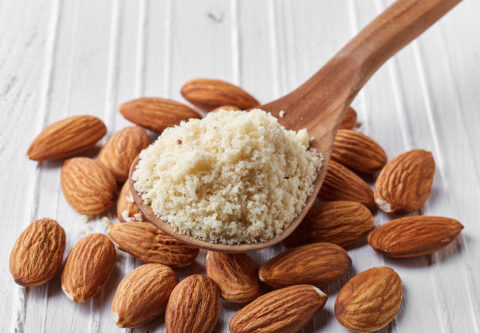
Almond flour/meal is a popular alternative among those who follow low-carb or grain-free diets. In fact, it’s a staple in Paleo and keto baking.
Made by grinding up skinless, blanched almonds, almond flour is slightly more processed than almond meal, which is ground almonds with the skin still on. The texture of almond meal is a bit courser and it may lend a hint of bitterness. Blanched almond flour is generally preferred for baking, but if the slight texture or taste difference of almond meal doesn’t bother you, then they can often be used interchangeably.
Almond flour has significantly fewer carbs and a much lower glycemic index than all-purpose flour, making it a good choice for people with diabetes who don’t want to spike their blood sugar. It is also higher in protein and fat than wheat and other gluten-free flours. The extra fat content gives baked goods a moist, rich texture.
Almonds are a great source of vitamin E, magnesium, and riboflavin. Per cup, almond flour’s macronutrient breakdown looks like this:
- Calories: 546
- Carbohydrates: 24g
- Fiber: 11.6g
- Protein: 20.2g
- Fat: 47g
Coconut Flour
 A popular alternative among keto and Paleo followers, coconut flour is grain- and gluten free and produced by grinding dried coconut meat.
A popular alternative among keto and Paleo followers, coconut flour is grain- and gluten free and produced by grinding dried coconut meat.
While fairly versatile, coconut flour can be a bit challenging to work with. It is very absorbent and can have a drying effect on baked goods. This is why recipes with coconut flour tend to call for a lot more eggs than you’d typically use in recipes using all-purpose flour. If substituting wheat flour with coconut flour at a 1:1 ratio, you may want to add 2 eggs and ¼ cup of liquid per ½ cup of flour.
Coconut flour can also have a heavy, gritty texture compared to other flours. You can combat this by sifting the flour before use, and also separating eggs, beating the whites separately, then folding them in to the flour/yolk mixture.
Coconut flour is rich in fiber and the trace mineral manganese. Per cup, its macronutrient content breaks down like this:
- Calories: 514
- Carbohydrates: 72g
- Fiber: 45g
- Protein: 21g
- Fat: 17g
Garbanzo Flour
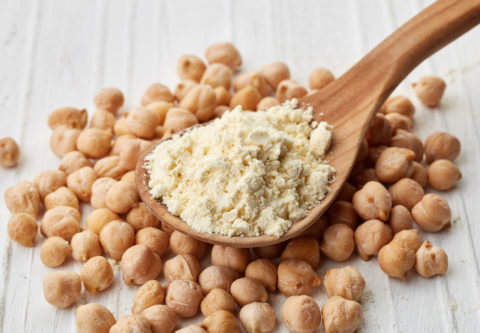
Garbanzo flour is popular in Indian and Middle Eastern cooking for dishes like falafel and papadums. It has a neutral to slightly-nutty flavor.
There are a couple varieties of garbanzo flour. One, called gram flour, is made by grinding hulled and split desi chickpeas into a fine powder. The other, chickpea flour, is produced by grinding dried kabuli chickpeas.
While both are similar, gram flour is finer and denser while chickpea flour is coarser and fluffier. Gram flour usually requires less water in recipes.
As a diehard Italian cook—and a cardiologist who understands the downsides of eating too much pasta—I love that grocery stores now sell pasta made from chickpea flour. Not only does it taste very similar to “regular” pasta, it contains much more protein and fiber. Plus, it is low glycemic and promotes a healthier blood sugar response than regular pasta.
Garbanzo flour is rich in folate and manganese, and a good source of protein, magnesium, copper, and iron. Here’s the macronutrient breakdown, per cup:
- Calories: 356
- Carbohydrates: 53g
- Fiber: 10g
- Protein: 20.6g
- Fat: 6.2g
Hazelnut Flour
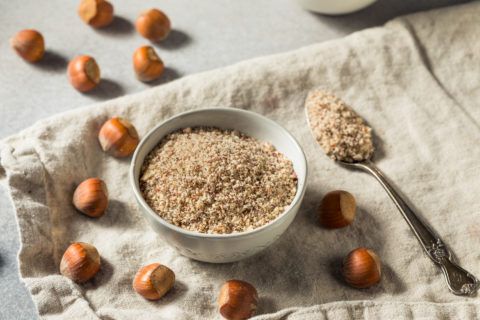 High in healthy monounsaturated fat, hazelnut flour is Paleo and keto friendly. It is also grain and gluten free. Like almond flour, it’s low glycemic and a great option if you’re watching your carb intake.
High in healthy monounsaturated fat, hazelnut flour is Paleo and keto friendly. It is also grain and gluten free. Like almond flour, it’s low glycemic and a great option if you’re watching your carb intake.
Not surprisingly, it has a slight nutty flavor that can sometimes come through in baked goods. It might not be ideal to mix with fruit flavors but is a great complement to chocolate, coconut, or vanilla.
Because it is so dense, it’s best to combine hazelnut flour with another flour, or use a recipe specifically formulated with this specific flour. (In my experience making olive oil cakes, using 100% hazelnut flour resulted in a very flat, albeit delicious and very moist, cake).
Hazelnut flour is a good source of iron and potassium. And like all nuts, hazelnuts are rich in heart-healthy monounsaturated fat. Per cup of chopped hazelnuts, the macronutrient profile is:
- Calories: 722
- Carbohydrates: 19.2g
- Fiber: 11.2g
- Protein: 17.2g
- Fat: 70g
Note that 1 cup of hazelnut flour will contain slightly more of each macronutrient.
Oat Flour
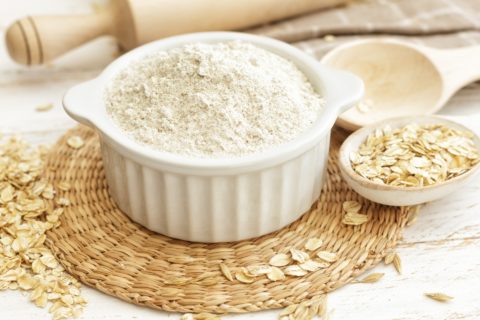
Since the entire oat is ground to make oat flour, it’s a whole grain food—great for your heart and overall health. Oats are also a gut-friendly food—gluten free, plus allergies or sensitivities are pretty uncommon.
Oat flour is much like wheat flour in cooking and baking. It creates light and fluffy baked goods and, in most cases, can be substituted in a 1:1 ratio with wheat.
Nutritionally, oats are heart healthy and high in fiber, protein, and certain minerals like magnesium and phosphorus. Macronutrient-wise, here’s the breakdown per cup:
- Calories: 420
- Carbohydrates: 68g
- Fiber: 6.8g
- Protein: 15g
- Fat: 9.5g
Oat flour is easy to make at home – you simply grind the oats in a blender or food processor (hypothetically, you could use a coffee grinder too; though I have never personally tried this). Just be sure to use organic oats as conventionally-produced oats are known to contain higher glyphosate residues.
While oats do not contain gluten, there could be potential for cross-contamination with wheat foods, depending on the manufacturing facility. If using oat flour in food for someone with celiac disease, be sure to look for certified gluten-free oats or oat flour.
Rice Flour
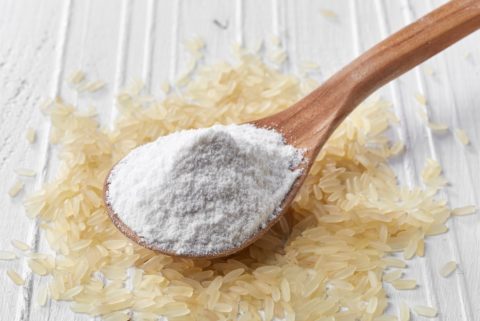 When you buy a standard gluten-free flour blend from the store, you can pretty much bet the house that the main ingredient will be rice flour.
When you buy a standard gluten-free flour blend from the store, you can pretty much bet the house that the main ingredient will be rice flour.
Rice is such a good alternative to wheat flour because it is taste-free, inexpensive, versatile, and can be substituted in a 1:1 ratio. Rice flour is a staple in parts of Asia, India, and Japan.
With all that said, white rice flour isn’t necessarily the most nutritious choice. If you can find brown rice flour, that at least contains the bran and germ—and therefore more nutrients. But most commercially produced gluten-free flours contain white rice flour.
In my opinion, rice flour is the gluten-free version of all-purpose white flour. What I mean by that is, rice flour is not going to affect your gut if you’re gluten free, but it’s also not going to give you much in terms of nutrients. There’s also the concern of arsenic in rice, so I don’t necessarily recommend baking with rice flour regularly.
In terms of nutritional value, white rice flour contains:
- Calories: 578
- Carbohydrates: 127g
- Fiber: 3.8g
- Protein: 9.4g
- Fat: 2.2g
To Sum It Up
As you can see, depending on your dietary needs/restrictions and health goals, there’s a flour for you. Cooking and baking have become a lot healthier and more interesting these days, thanks to all the options now readily available. And these are only a fraction of the dozens of options out there. You’ll also find flours produced from flax, buckwheat, walnuts, millet, sorghum, and pecans, just to name a few!
I personally prefer to use almond or hazelnut flours because –like olive oil- they are rich in healthy, monounsaturated fat which not only is good for the heart and brain, but helps slow the blood sugar response to any sugars in the dish (usually the case with baked goods). Nut flours are also higher in protein than many other flours, which also helps keep blood sugar in a healthy zone. I also like chickpea flour, for its nutritional value and protein content. In savory dishes like meatloaf or meatballs, however, I prefer to use oat flour (instead of bread crumbs), as it doesn’t not add nutty flavor to these dishes.
I encourage you to expand your horizons when it comes to baking or cooking with different types of flours. A simple online search will yield plenty of tried-and-true recipes using various flours, so that you end up with the best result possible.
Bon appetit!
References
- S. Code of Federal Regulations. 21 CFR 137, section 105: Flour. Last accessed Feb. 22, 2022 at https://www.accessdata.fda.gov/scripts/cdrh/cfdocs/cfcfr/CFRSearch.cfm?CFRPart=137&showFR=1
- Combs GF. Wheat: the Whole (Grain) Story. ARS.USDA.gov, last accessed Feb. 22, 2022 at https://www.ars.usda.gov/plains-area/gfnd/gfhnrc/docs/news-2013/wheat-the-whole-grain-story/
- Nutritive Value of Foods. Last accessed Feb. 22, 2022 at https://www.ars.usda.gov/ARSUserFiles/80400525/Data/hg72/hg72_2002.pdf
- SELF Nutrition Data. Wheat flour, white, all-purpose, enriched Nutrition Facts & Calories. Last accessed Feb. 22, 2022 at https://nutritiondata.self.com/facts/cereal-grains-and-pasta/5745/2
- SELF Nutrition Data. Nuts, almonds. Nutrition Facts & Calories. Last accessed Feb. 22, 2022 at https://nutritiondata.self.com/facts/nut-and-seed-products/3085/2
- Calorie Friend. Calories in Coconut Flour. Last accessed Feb. 22, 2022 at https://caloriefriend.com/en/food/4696-coconut-flour/4
- SELF Nutrition Data. Chickpea flour (besan). Nutrition Facts & Calories. Last accessed Feb. 22, 2022 at https://nutritiondata.self.com/facts/legumes-and-legume-products/4406/2
- Goñi I and Valentı́n-Gamazo C. Chickpea flour ingredient slows glycemic response to pasta in healthy volunteers. Food Chemistry. 2003 Jun;81(4):511-15.
- org. Oat flour, partially debranned. Last accessed Feb. 22, 2022 at https://www.nutritionvalue.org/Oat_flour%2C_partially_debranned_nutritional_value.html
- SELF Nutrition Data. Rice flour, white. Nutrition Facts & Calories. Last accessed Feb. 22, 2022 at https://nutritiondata.self.com/facts/cereal-grains-and-pasta/5726/2
- Diabetes Council. 20 Healthy Flours from Lowest to Highest Carbohydrates. Last accessed Feb. 22, 2022 at https://www.thediabetescouncil.com/20-healthy-flours/
- Briney, Amanda. “History and Overview of the Green Revolution.” ThoughtCo, Dec. 6, 2021, thoughtco.com/green-revolution-overview-1434948.
- Food and Agriculture Organization of the United Nations. Towards a New Green Revolution. Last accessed Feb. 2022 at https://www.fao.org/3/x0262e/x0262e06.htm
- Pingali PL, Green Revolution: Toward 2.0. Proceedings of the National Academy of Sciences Jul 2012, 109 (31) 12302-12308; DOI: 10.1073/pnas.0912953109 https://www.pnas.org/content/109/31/12302
©2022 Stephen Sinatra, MD and Vervana, LLC. All rights reserved.











